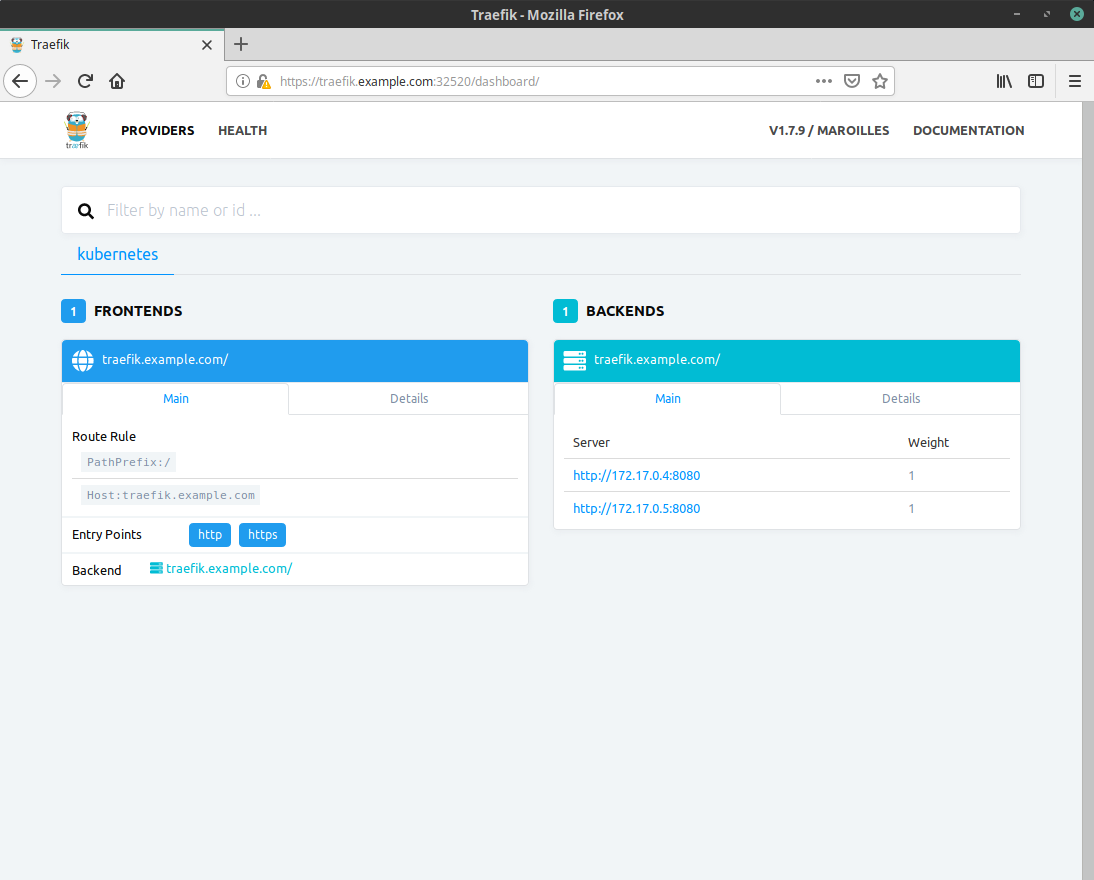DEPRECATED
kubernetes-traefik
Traefik has this feature in versions 1.7 and newer
Prerequirements
Create TLS certificate that we'll use for UI:
openssl req -x509 -nodes -days 3650 -newkey rsa:2048 -keyout ./tls.key -out ./tls.crt -subj "/CN=traefik.example.com"
After certificates are created, put them in secret that is described in tls_secret.yaml.
Please note that tls.crt field must have value that you get after execute command:
cat tls.crt | base64 -w0
Repeat the same command for tls.key field:
cat tls.key | base64 -w0
Note that example certificates are matching traefik.example.com CN.
Ship it
- Create namespace:
kubectl create namespace traefik
- Modify
entryPoints.traefik.auth.basicsection ofdeployment.yamlwith new admin username/password
htpasswd -nb admin new_password_you_choose
- Apply deployment file and service account file:
kubectl apply -f ./ -n traefik
Recap
We need this k8s components:
- namespace
- service account
- TLS secret
- cluster role and cluster role binding
- configmap
- deployment
- service for http and https
- service for Traefik dashboard
- an ingress
All componentes are described in *.yaml files.
ConfigMap
---
apiVersion: v1
kind: ConfigMap
metadata:
name: traefik-configmap
namespace: traefik
data:
traefik.toml: |
defaultEntryPoints = ["http","https"]
[entryPoints]
[entryPoints.http]
address = ":80"
[entryPoints.https]
address = ":443"
[entryPoints.https.tls]
[[entryPoints.https.tls.certificates]]
CertFile = "/ssl/tls.crt"
KeyFile = "/ssl/tls.key"
[entryPoints.traefik]
address = ":8080"
[entryPoints.traefik.auth.basic]
users = ["admin:$apr1$zjjGWKW4$W2JIcu4m26WzOzzESDF0W/"]
[kubernetes]
[kubernetes.ingressEndpoint]
publishedService = "traefik/traefik"
[ping]
entryPoint = "http"
[api]
entryPoint = "traefik"
We have three default entry points, http,https and traefik. First and second are listening on ports 80 and 443 and they're self-explanatory. Third one is used for Traefik UI Dashboard. We want to have UI secured with Basic Auth + TLS certificates.
It's very important to have publishedService = "traefik/traefik-ingress-controller-http-service" set. value traefik/traefik-ingress-controller-http-service has format namespace/service name. If you plan to change the name of the namespace and service, you have to change this values to values that matches to your environment.
Service
First service we need here is traefik-ingress-controller-http-service. It will expose http and https entry points defined in ConfigMap to the LoadBalancer. If you check LoadBalancer Security Group (ingress), ports 80 and 443 are opened. K8S will automatically create a LoadBalancer and join a node(s) that is/are running Traefik pods. If you want to create internal ELB as I did, you have to define annotations.
Service for UI Dashboard
This is the cool part! I wanted to have Dashboard under https since it requires basic authentication. The Dashboard is running on port :8080 and we need to redirect it to use SSL. Service is very simple and real magic will happen in the Ingress object.
Ingress for UI Dashboard
The magic part of a proxying secured Traefik Dashboard through Traefik itself is defined in Ingress object. Controlling Traefik ingress is possible by using Traefik annotations
---
apiVersion: extensions/v1beta1
kind: Ingress
metadata:
name: traefik-ingress-controller-dashboard-ingress
namespace: traefik
annotations:
kubernetes.io/ingress.class: traefik
traefik.ingress.kubernetes.io/frontend-entry-points: http,https
traefik.ingress.kubernetes.io/redirect-entry-point: https
traefik.ingress.kubernetes.io/redirect-permanent: "true"
spec:
rules:
- host: traefik.example.com
http:
paths:
- path: /
backend:
serviceName: traefik-ingress-controller-dashboard-service
servicePort: 8080
We need 4 annotations and they are all self-explanatory. Of course, to get it fully working you have to create DNS record traefik.example.com that will point your ELB.
Minikube
If you want to run this example with minikube, edit traefik-ingress-controller-http-service, change type from LoadBalancer to NodePort.
Edit /etc/hosts and add record minkube_ip_address traefik.example.com.
Note: Default minikube IP address is 192.168.99.100.
You can inspect which port is assigned by executing:
NAME TYPE CLUSTER-IP EXTERNAL-IP PORT(S) AGE
traefik-ingress-controller-dashboard-service ClusterIP 10.96.120.63 <none> 8080/TCP 2m23s
traefik-ingress-controller-http-service NodePort 10.108.120.206 <none> 80:30530/TCP,443:32520/TCP 2m23s
Go to your browser and open (in this case): https://traefik.example.com:32520, authenticate with admin/admin.
